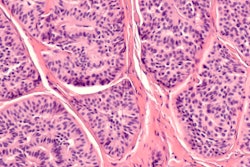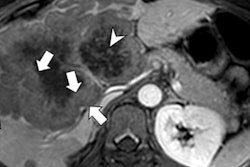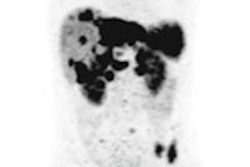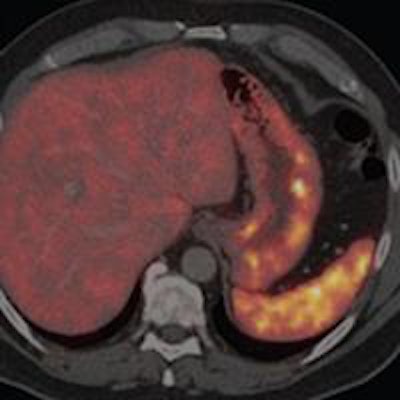
German researchers have confirmed the efficacy of PET/CT with the radiopharmaceutical gallium-68 (Ga-68) DOTATATE for detecting the recurrence of neuroendocrine tumors (NETs), in a study published in the February issue of Radiology.
PET/CT with Ga-68 DOTATATE achieved high sensitivity (90%) and good specificity (82%) for determining the recurrence of NETs. It also ruled out recurrence with a high negative predictive value (90%), according to lead author Dr. Alexander Haug, from Ludwig Maximilian University, and colleagues.
However, the group also found decreased sensitivity and positive predictive value for two readers who were blinded to patients' clinical information. The finding highlights the importance of using clinical parameters to ensure diagnostic accuracy, the authors wrote (Radiology, February 2014, Vol. 220:2, pp. 517-525).
Rising incidence
The incidence of neuroendocrine tumors has increased over the past several decades, due in part to improvements in discovering them at a localized stage using imaging. While the early detection of NETs allows for potentially curative treatment, the five-year survival rate for patients is less than 80% due to recurrence, the authors noted.
There is some precedence for using Ga-68 DOTATATE PET/CT to detect suspected NETs. Based on the findings of a 2009 study that confirmed its efficacy, Ga-68 DOTATATE PET/CT for NET recurrence is recommended by the European Neuroendocrine Tumor Society (Neuroendocrinology, August 2009, Vol. 90:2, pp. 227-233).
However, there were no published studies on the efficacy of Ga-68 DOTATATE PET/CT for following up patients after resection to treat the tumors, Haug and colleagues wrote.
Their retrospective study enrolled 63 patients with a mean age of 58 years (± 14 years). The 34 men and 29 women were referred between 2007 and 2011 to the university's department of nuclear medicine for imaging after resection of NETs.
Patients were included in the study if they had a history of resection of the primary NET without suspicion of residual disease and no proven evidence of NET recurrence. Primary NETs were located in a number of areas, including the small bowel, pancreas, colon, lung, thymus, and stomach. Their final diagnosis was determined with histopathologic verification or clinical follow-up.
Whole-body PET scans were performed in 3D mode using one of two 64-slice PET/CT scanners (Biograph 64 TruePoint, Siemens Healthcare, or Discovery, GE Healthcare).
Ga-68 DOTATATE PET/CT results were interpreted by two readers who had access to the patients' clinical information, while two other readers assessed the images while blinded to patient data.
The recurrence or absence of NETs was confirmed through histopathology or follow-up exams during a median follow-up after PET of 24 months (range, four to 52 months).
Tumor detection
Neuroendocrine tumors recurred in 29 (46%) of the 63 patients, according to the reference standard. The median time between curative surgery and recurrence was 41 months, ranging from three to 348 months.
PET/CT with Ga-68 DOTATATE correctly identified 26 of the 29 patients with recurrent NET, and it ruled out NET recurrence in 28 of 34 patients. This translated to a sensitivity of 90% and specificity of 82%, the authors wrote.
Six patients had false-positive results and three had false-negative findings, resulting in a positive predictive value (PPV) of 81% (26 of 32), negative predictive value (NPV) of 90% (28 of 31), and accuracy of 86% (54 of 63) for Ga-68 DOTATATE PET/CT.
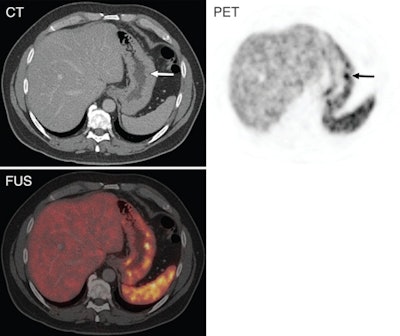 Resection of a duodenal gastrinoma in 2006 and clinical suspicion of recurrence in August 2008 in a 54-year-old man. On the Ga-68 DOTATATE PET/CT scan, intense uptake suspicious for recurrent NET within the gastric wall was observed. In September 2008, a gastrinoma with an 8-mm diameter was resected. CT shows no suspicious findings (arrow), while PET shows an intense focal uptake (arrow). Fused (FUS) PET/CT image indicates intense uptake located within the gastric wall. Images courtesy of Radiology.
Resection of a duodenal gastrinoma in 2006 and clinical suspicion of recurrence in August 2008 in a 54-year-old man. On the Ga-68 DOTATATE PET/CT scan, intense uptake suspicious for recurrent NET within the gastric wall was observed. In September 2008, a gastrinoma with an 8-mm diameter was resected. CT shows no suspicious findings (arrow), while PET shows an intense focal uptake (arrow). Fused (FUS) PET/CT image indicates intense uptake located within the gastric wall. Images courtesy of Radiology.Sensitivity and positive predictive value for the two blinded readers were "markedly decreased" without the patients' clinical data, according to Haug and colleagues.
"A recall bias cannot be ruled out, as one of the reviewers partly participated in the clinical routine workup of these patients," they wrote. "Blinded review resulted in decreased sensitivity but increased specificity because of a reduced number of false-positive findings."
| Readers blinded to patient clinical data | ||
| Reader 1 | Reader 2 | |
| Sensitivity | 79% (23 of 29) | 76% (22 of 29) |
| Specificity | 85% (29 of 34) | 94% (32 of 34) |
| PPV | 82% (23 of 28) | 92% (22 of 24) |
| NPV | 83% (29 of 35) | 82% (32 of 39) |
Some subgroups were evaluated in the study: One group underwent regular follow-up despite no indication of increased levels of tumor markers or clinical suspicion of NET recurrence. Among these individuals, Ga-68 DOTATATE PET/CT helped identify seven of eight patients with recurrent NET and helped exclude recurrence in 21 of 22 patients. Ga-68 DOTATATE PET/CT also led to false-positive and false-negative results in one patient each, indicating PPV of 87%, NPV of 95%, and accuracy of 93%.
Among a subgroup of 45 patients with gastroenteropancreatic NET, Ga-68 DOTATATE PET/CT results were comparable to findings for the entire study cohort. Sensitivity was 94%, specificity was 89%, PPV was 85%, NPV was 96%, and accuracy was 91%.
"Overall, these findings indicate a substantial value of Ga-68 DOTATATE PET/CT in the follow-up of NET patients," Haug and colleagues wrote. "However, positive findings on the PET/CT scan have to be considered with caution, as rare instances of false-positive results may occur, for instance due to inflammatory changes."
The authors cited several limitations of the study, including the fact that additional cases of delayed NET recurrence might be expected even with a median follow-up of 24 months. In addition, patients in the current study had varying risks for recurrence, given that some had increased levels of tumor markers.




